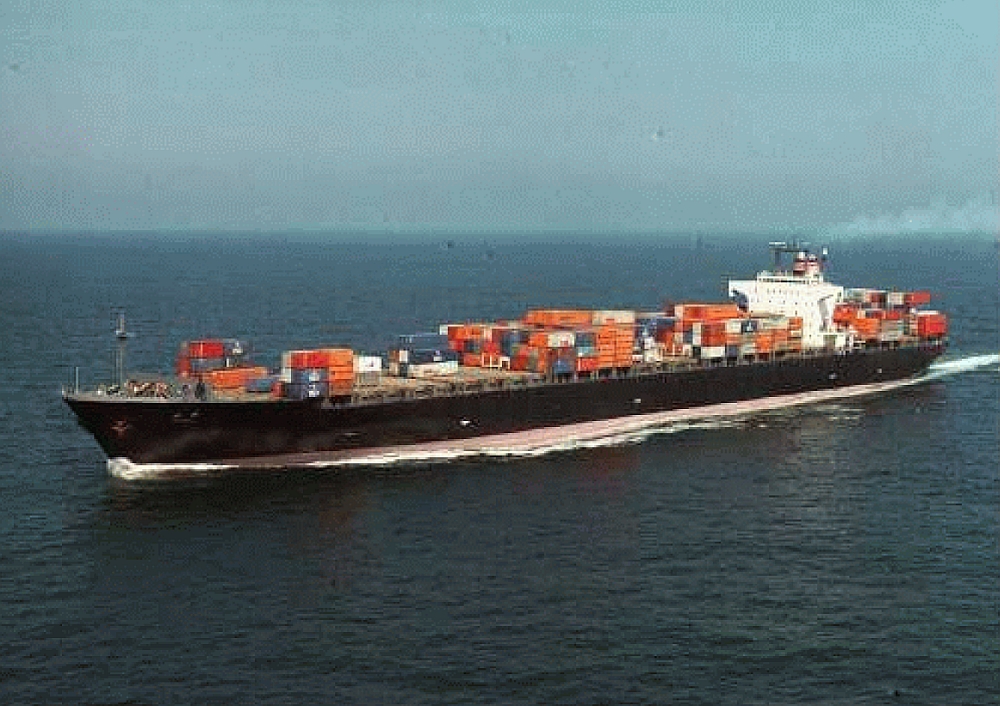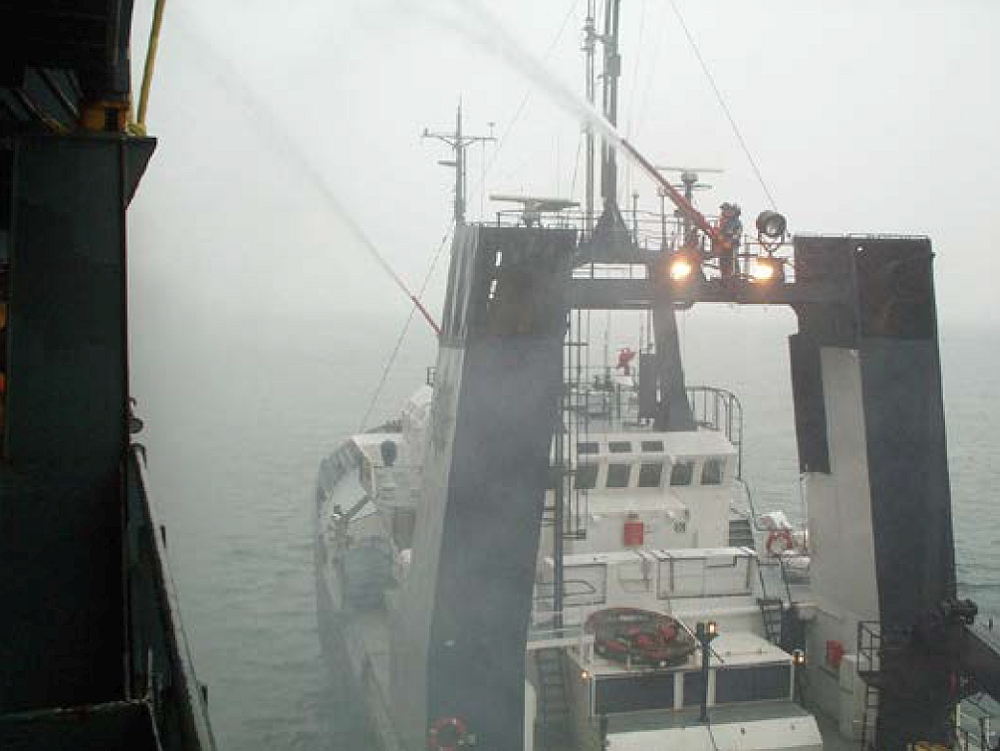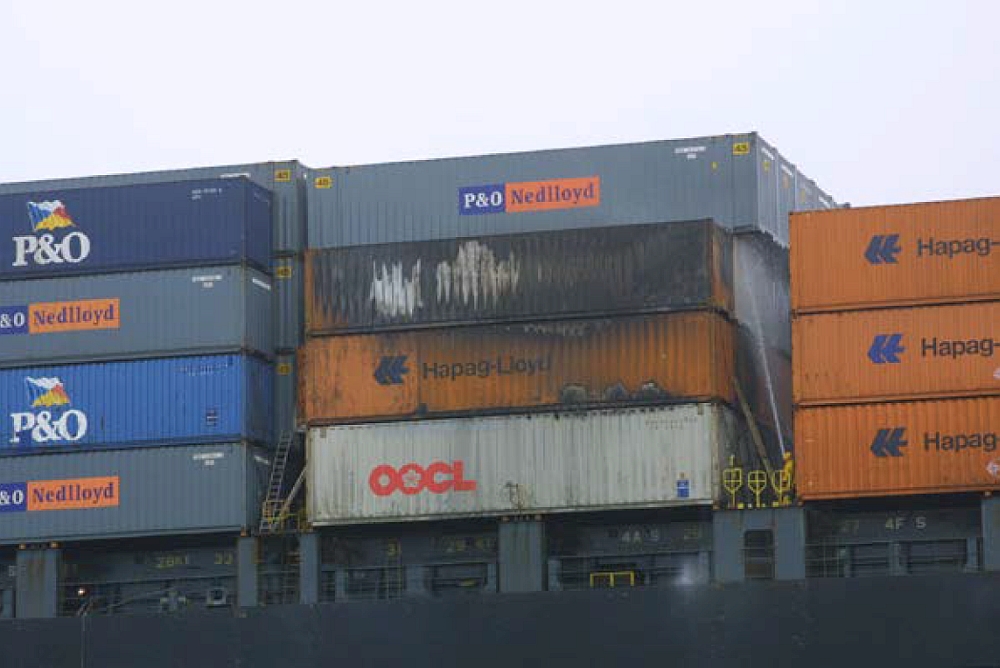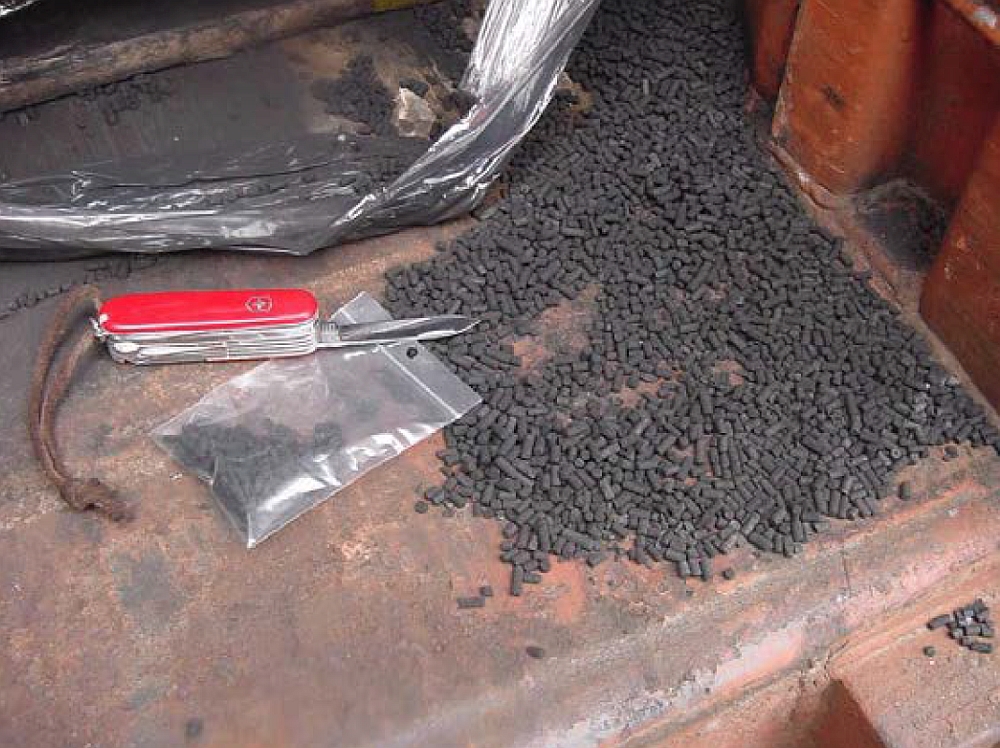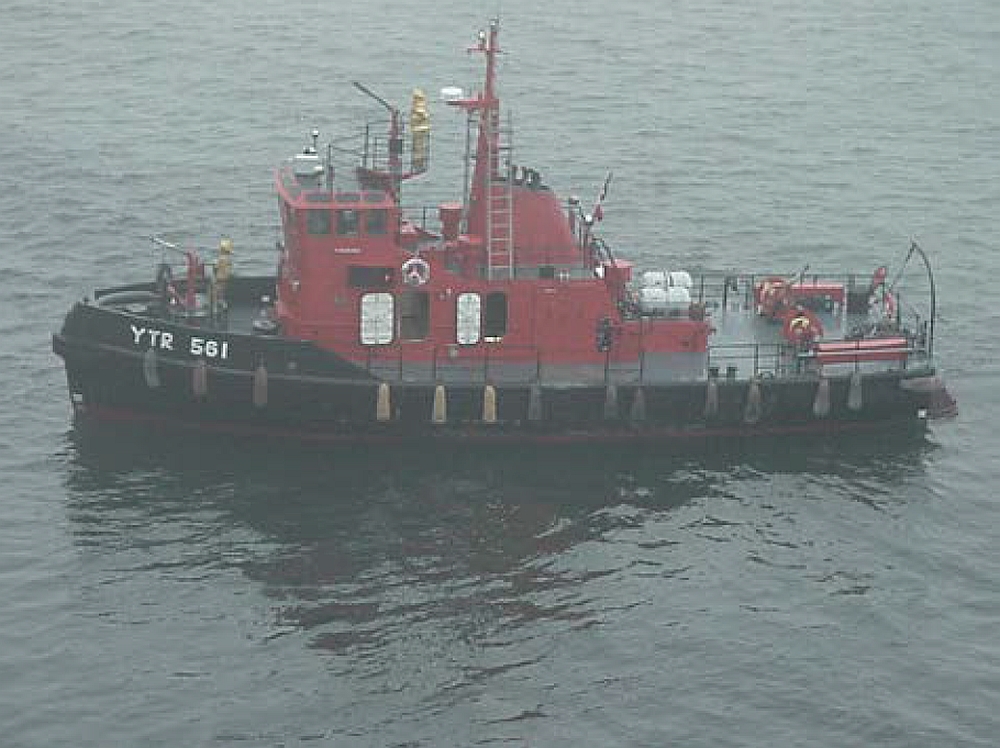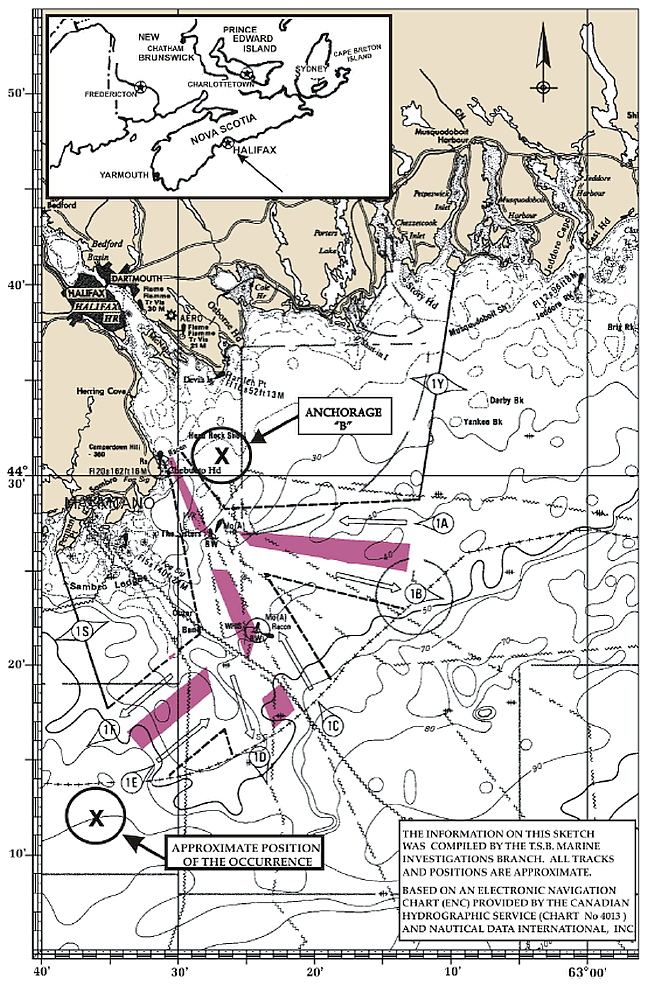Container fire
Container vessel Kitano
Off Chebucto Head, Nova Scotia
The Transportation Safety Board of Canada (TSB) investigated this occurrence for the purpose of advancing transportation safety. It is not the function of the Board to assign fault or determine civil or criminal liability. This report is not created for use in the context of legal, disciplinary or other proceedings. See Ownership and use of content. Masculine pronouns and position titles may be used to signify all genders to comply with the Canadian Transportation Accident Investigation and Safety Board Act (S.C. 1989, c. 3).
Summary
On 22 March 2001, while en route from New York, New York, to Halifax, Nova Scotia, the container vessel Kitano reported a fire on the foredeck at about 1400. The fire originated in one of the above deck containers, located on the starboard side, just forward of amidships. The vessel was not allowed to enter the inner harbour until the following afternoon due to concerns with the contents of containers adjacent to the fire. As shore-based fire-fighting resources were unable to board the vessel due to the high winds and seas, the vessel's crew fought the fire. The vessel was secured alongside in Halifax on 24 March 2001, where the damaged containers were offloaded.
Factual information
| Name | "KITANO" |
|---|---|
| Registry/Licence Number | 131968 |
| Port of registry | Tokyo |
| Flag | Japan |
| Type | Container Ship |
| Gross tonnage | 50618 |
| LengthFootnote 1 | 288.31 m |
| Draught | 13.025 m |
| Built | Koyo Dockyard Company Limited, 1990 |
| Propulsion | 8 cylinder B & W Mitsui Tamano 31 538 kW, single screw. |
| Crew | 22 |
| Registered Owner | Nippon Yusen Kabushiki Kaisha Tokyo, Japan |
Description of the vessel
The Kitano is a steel-hulled container ship with its wheelhouse, accommodation and engine-room located aft of the seven forward cargo holds and forward of an after cargo hold. The eight cargo holds and single engine-room are divided by ten watertight bulkheads. The vessel has a cargo container capacity of 3618 twenty foot equivalent units (T.E.U.) and is equipped to carry 20, 40 and 45 foot general purpose containers above and below deck.
History of the voyage
The Kitano departed New York, New York, at 0730 Atlantic standard time,Footnote 2 on 21 March 2001 for Halifax, Nova Scotia and ports in Europe, the Middle East and Asia. At 1600, while the vessel was preparing to enter the Halifax Vessel Traffic System (VTS), a plume of smoke was noticed issuing from the midship area of the vessel. Further investigation revealed that the container located in cargo bay 301184 was on fire. The general alarm was immediately sounded and as the fire party prepared to fight the fire, glowing pellets were noticed falling from the bottom of the container in bay 301184Footnote 3 on to the container 301182 directly below.
The spray from the fire hoses was directed at the glowing pellets, both extinguishing and washing them out from between the containers. At 1616, an entry in the vessel's wheelhouse logbook reports the fire under control. Although a MAYDAY was not declared, at approximately 1636, the Kitano notified Halifax Coast Guard Radio (VCS) that it had a fire in a container onboard and the crew was attempting to extinguish the blaze. VCS notified the Joint Rescue Coordination Centre (JRCC) who immediately commenced tasking available surface and air search and rescue (SAR) resources to render assistance. Over the next three-quarters of an hour, authorities determined that the container 301184 contained a cargo of activated carbon pellets. Just forward of this bay were two containers loaded with barrels of camphene-90 wax, a class 4.1 dangerous cargo. As there was concern about the proximity of this class of cargo to the fire, permission to enter the harbour was denied and VTS directed the vessel to anchorage Bravo (B).
The wind and sea conditions stopped the fire tug CFAV Firebird from proceeding beyond the middle harbour and prevented the other surface SAR vessels from getting alongside the vessel for any length of time to assist. Plans to airlift military fire fighting teams to the vessel were drawn up, but had to be discarded due to the extreme weather conditions. During the evening and with the vessel rolling 10°, the crew continued to fight the fire by applying boundary cooling as it slowly spread to adjacent containers. By midnight the fire had climbed to the third tier and was thought to have spread to four containers. Throughout the night, various surface SAR units were tasked and relieved each other. At approximately 0630, the next morning an ocean-going salvage tug, the Ryan Leet, entered into a Lloyds Open Form 2000Footnote 4 agreement (LOF 2000) with the owners of the vessel. The Ryan Leet arrived on the scene at approximately 0900, but was unable to assist due to the high winds and seas.
At approximately 1040, the vessel's crew started opening containers for a more direct fire-fighting effort and by 1300, reported that two containers (300984 and 301184) were confirmed extinguished. At 1300, a harbour pilot boarded the vessel to assess the situation and liaise between the vessel and the various federal, provincial and municipal agencies ashore. By 1400, the situation onboard the Kitano was considered under control and the vessel was cleared to enter the middle harbour. The vessel weighed anchor and, with the assistance of a harbour pilot, entered the middle harbour. At 1620, the Kitano dropped anchor in anchorage one. Shortly afterwards the vessel's crew resumed their fire fighting effort and opened a third container (300986).
With the vessel safely anchored, a four-man military fire team with thermal imaging equipment boarded the vessel to carry out a fire assessment. Shortly after the military fire assessment team boarded the vessel, a seven-person salvage fire team also boarded in order to assist with the firefighting efforts. At 1655, the Ryan Leet came alongside the Kitano and started to fight the fire in container 300986 using two fire monitors. At 1700, the vessel's crew was stood down and relieved by the seven firefighters from the salvage company. At 1810, the vessel's crew rejoined the fire fighting effort and at 1940, the harbour pilot/liaison was relieved by his replacement. At 2050 the fire in container 300986 was confirmed extinguished. The final container (301186) was opened up at 2115, and one hour later at 2215, the last of the four (loaded) containers was confirmed extinguished. With the firefighting efforts now complete, the firefighters as well as the Ryan Leet remained on scene to monitor the situation and relieve the vessel's own crew.
On the morning of 24 March 2001, the Kitano was cleared by VTS to proceed to the container pier in Fairview Cove. At 0750, the vessel weighed anchor and under the escort of the Ryan Leet and two harbour tugs, proceeded to the Ceres container terminal. At 0940, the Kitano was secured alongside and the damaged containers as well as those adjacent to the fire were removed and inspected. Crews from both the Halifax Regional Municipality (HRM) Fire Service and the salvage company stood by the vessel until the following day as normal cargo operations resumed. On the morning of 26 March 2001, after discharging cargo destined for the port, the Kitano departed Halifax.
Injuries to persons
None of the vessel's personnel was injured.
Damage to the vessel and cargo
Other than some superficial damage to the coating on the hatch cover in way of the containers, there was no apparent damage to the vessel.
Shortly after the vessel was secured alongside, 16 containers including the 15 directly involved in or in close proximity to the fire were removed from the vessel for inspection and assessment. Only one container (300986) loaded with hard cover books had a deep seated fire which required additional attention by the HRM Fire Service. Of the 15 containers removed from the area of the fire, all but one suffered varying degrees of fire, smoke and water damage. The sixteenth container removed had been stored in a cargo hold and contained an identical cargo of the activated carbon pellets as container 301184. An inspection of this container did not reveal a problem with its cargo.
Damage to the environment
There was no apparent damage caused to the ocean environment.
Vessel certification
The Kitano was crewed, certified, and equipped in accordance with existing regulations.
Personnel certification
The master and watch officers of the Kitano were certificated for the class of their vessel and for the type of voyage.
Personnel history
The master had 30 years experience at sea and approximately three years as commanding officer. He had joined the vessel in Singapore five weeks earlier. This was his second trip on a container ship.
Weather
The wind and sea conditions encountered as the vessel departed New York were recorded as winds from the east-northeast at force 7 and an air temperature of 7°C. At the time of the occurrence these conditions had deteriorated to winds from the east at force 8, with an air temperature of 4°C. At the height of the occurrence, the weather had further deteriorated to winds from the east-northeast at force 10 with an air temperature of 1°C.
Activated carbon pellets
The container in which the fire started contained 14 - 115 kg drums and 288 - 44 kg open mesh bags of activated carbon pellets impregnated with potassium hydroxide (caustic potash). The bags of carbon pellets were bundled and plastic wrapped onto 14 wooden pallets. The activated carbon pellets are commonly used for the desulphurisation of gases and the removal of acidic contaminants such as hydrogen sulfide, hydrogen chloride and mercaptans.
A second container with 360 - 44 kg open mesh bags of an identical cargo was also being carried onboard the vessel at the time of the occurrence. Similar to the first container, the cargo of carbon pellets was bundled and plastic wrapped onto 18 wooden pallets. Each pallet of cargo had an estimated volume of approximately 1.5 m³. Neither the second container nor its cargo was directly involved in the incident.
Response
Immediately after the Kitano informed Halifax VCS of a container fire onboard, the JRCC assumed the role of SAR mission co-ordinator and tasked three surface units, the CFAV Firebird, the CCGS Earl Grey and the CCGC Sambro as well as three Department of National Defence (DND) SAR aircraft. Due to the extreme weather conditions, all the SAR resources were limited in their SAR capabilities.
The three SAR aircraft were forced to return to their base to await improved weather conditions, the CFAV Firebird could only proceed as far as Maughers Beach while the CCGS Earl Grey and the CCGC Sambro were forced to heave to and monitor the situation. Several hours later the HMCS Moncton and the HMCS Goose Bay, with quickly assembled ad hoc fire teams, were tasked by the DND Military Operations Centre (MOC). At approximately 0500, the CCGS Sir William Alexander relieved the CCGS Earl Grey.
Shortly after midnight on 23 March 2001, the JRCC determined that there was no longer any further risk to life and terminated its role as the SAR mission co-ordinator. The Canadian Coast Guard (CCG) Regional Operations Centre assumed the role of lead agency under the auspices of Environmental Response. As the fire-fighting capabilities of all the previously tasked surface units had proven inadequate in the existing sea and weather conditions, an attempt was made by the CCG to procure the services of the Ryan Leet, a sea-going tug with enhanced firefighting abilities. By then the owners of the Ryan Leet were already in negotiations with the owners of the Kitano for a LOF 2000 and therefore declined to enter into negotiations with the CCG. The next morning, the master of the Kitano signed a LOF 2000 with Secunda Marine Services Ltd., the owners of the Ryan Leet, and the tug sailed to assist. When the Ryan Leet arrived on scene, weather and sea conditions prevented it from offering any direct assistance and it was forced to heave to and stand-by.
At 1200, the role of lead agency was turned over to Transport Canada Marine Safety and one hour later a Halifax pilot, sent to liaise between the vessel and the authorities ashore, boarded the Kitano. With the situation now under control, the harbour master, who would soon assume the role of lead agency, cleared the vessel to enter the harbour and proceed to anchorage one.
The HRM Fire Service was prepared to intervene once the vessel was secured alongside, but as its members are not trained or equipped to fight shipboard fires while a vessel is in the stream, they too were unable to offer assistance. Discussions that morning between the HRM Fire Service and DND for DND assistance were unsuccessful. A verbal request for DND assistance was made by the HRM Fire Service using the term "Aid to Civilian Powers". This term had been used in the past by the HRM Fire Service to obtain DND assistance but on this occasion the request was denied. It was not until the HRM Fire Service made an official request through the HRM Emergency Measures Organization (EMO), through the Provincial EMO to the Office of Critical Infrastructure Protection and Emergency Preparedness that DND agreed to task the CFAV Firebird and put a fire team onboard to assess the situation. The military assessment team was under instructions to assess, but not to engage the fire.
By the time clearance was granted for the Kitano to enter the harbour, the fire in two of the four containers involved in the fire had been extinguished. The harbour master believed that once the vessel anchored inside the harbour, DND firefighters would board the Kitano and extinguish the fire in the other two containers. As the vessel prepared to enter the harbour, the harbour master learned that the services of the CFAV Firebird and the DND firefighters would only be available in an assessment capacity.
The harbour master was soon in contact with Secunda Marine Services Ltd. and informed them that the Kitano was on its way in, and the extent of DND participation to be expected once the vessel was anchored. Secunda Marine Services Ltd. completed its preparations, and, with a seven-person fire fighting and salvage team, proceeded to meet the vessel at anchorage one.
When the Kitano was finally anchored safely in the inner harbour, the military assessment team boarded the vessel, followed by the salvage company fire team. The salvage company firefighters together with the team from DND completed an initial assessment of the situation. The salvage company firefighters then requested the Ryan Leet to come alongside and using its fire monitors, the salvage tug directed water at the flames emanating from a container which the Kitano's crew had opened immediately after anchoring. Once the visible flames were sufficiently knocked down, the Ryan Leet commenced boundary cooling and the firefighters, having already relieved the vessel's exhausted crew, commenced attacking the fire using fire hoses and portable equipment.
By late that evening, the fire in the two remaining containers had been extinguished. As a precautionary measure, the salvage company firefighters and the Ryan Leet remained with the vessel throughout the night. The following morning the vessel was cleared to proceed to the Ceres container pier where the damaged containers were removed from the vessel.
Fire safety in Canadian ports, harbours and seaway
Since 1989, at least tenFootnote 5 major fires have occurred aboard vessels of various types and sizes across Canada involving a response by municipal shore-based firefighters.
Occurrences involving the following four vessels are of particular interest: H.M. Griffith, Ambassador, Petrolab and Windoc.
On 27 September 1989, the bulk carrier H.M. Griffith experienced a fire in the tunnel area under its No. 3 cargo hold. Post-occurrence concerns were raised, in a St. Lawrence Seaway internal report, about communications and coordination of firefighting efforts between the vessel's crew and the municipal fire department. The report recommended that the St. Lawrence Seaway arrange a meeting with local fire chiefs to establish procedures and clarify roles between the Seaway and municipal fire departments.
In December 1994, during the unloading of a cargo of rock phosphate in the Port of Belledune, New Brunswick, a fire broke out in the conveyor belt system of the bulk carrier Ambassador. The combined efforts of the ship's crew and several shore-based fire departments were required to bring the fire under control; it was fully extinguished some 28 hours later.
In Canadian ports and harbours, the responsibility for risk assessment and emergency plans generally rests with the local harbour master or port official, while firefighting is provided by the local fire department. Concerned that many municipal fire departments may not have properly trained personnel to fight shipboard fires, the Transportation Safety Board of Canada (TSB) made these three recommendations:
The Department of Transport [should] conduct a special audit of fire-fighting facilities at Canadian ports and harbours under its jurisdiction to ensure that an adequate year-round capability exists to contain shipboard fires.
Transportation Safety Recommendation M96-06 (issued October 1996)
The Department of Transport [should], in collaboration with ports and harbour authorities, take measures to ensure that shore-based fire brigades expected to support on-board fire-fighting receive appropriate training.
Transportation Safety Recommendation M96-07 (issued October 1996)
The Department of Transport [should] take appropriate measures to ensure that on-board fire-fighting capabilities of vessels in Canadian ports and harbours are functional and readily available during cold weather operations.
Transportation Safety Recommendation M96-08 (issued October 1996)
In its response, the Department of Transport (TC) indicated that the Canadian Association of Fire Chiefs (CAFC) is responsible for the standards and training of shore-based fire brigades. The CAFC has no jurisdiction over non-member fire departments. The majority of public harbours have only a local volunteer force to fight small fires, and their training generally does not include entering and fighting fires in restricted places. TC also indicated that there is no legislated requirement for public harbours and ports to engage in firefighting activities aboard vessels.
In May 1997, the CAFC forwarded a questionnaire to selected municipalities to determine their firefighting capabilities and the type and extent of assistance that could be called upon by operators of marine terminals in the event of a fire on board a vessel in port. Information provided to the TSB indicates that fire departments in the Welland Canal area were not sent copies of this survey, and therefore did not have an opportunity to participate. Overall, the survey did not receive wide enough distribution to provide enough useful information to evaluate the scope of marine firefighting experience among municipal fire departments.
On the evening of 19 July 1997, an explosion and fire occurred on board the tanker Petrolab alongside the government wharf at St. Barbe, Newfoundland, while the crew was washing cargo oil tanks in preparation for loading cargo. The ship's owner was killed and three crew members were injured by the explosion; one later died in hospital.Footnote 6 The combined efforts of two CCG vessels and several shore-based fire departments were deployed to fight the fire. The local fire department was not equipped with foam and had no training in fighting shipboard - in particular, oil tanker - fires. As a result, the fire departments did not bring the shipboard fire under control in its early stages and burning paint on the vessel's outer hull spread the fire to the creosote-impregnated piles of the government wharf. Both the ship and the government wharf were destroyed before the fire was fully extinguished some 63 hours later.
In August 2001, while proceeding downbound under a bridge in the Welland Canal, at Allanburg, Ontario, the bulk carrier Windoc was struck by the bridge's vertical-lift span, which was lowered before the vessel had passed clear of the bridge structure. The vessel's wheelhouse and funnel were destroyed. The vessel drifted downstream, caught fire, grounded about 800 metres from the bridge and was declared a constructive total loss. The bridge sustained structural damage, and the Welland Canal was closed to vessel traffic for two days. The Thorold fire department, which was first to respond, had little or no experience or training in shipboard firefighting and was not equipped with suitable boats for transporting firefighters to and from the shore and the Windoc. Boats were provided by another fire department. Difficulties were experienced by the responding fire departments in establishing a sufficient water pressure to fight the fire. At the time of the Windoc occurrence, there were no firefighting procedures nor memorandum of understanding between the St. Lawrence Seaway and local fire departments in the Canal area.
Other occurrences, in particular a cargo fire on board the Southgate in 1998, further highlighted inadequacies in the efficacy of shipboard firefighting by shore-based fire departments.
Analysis
Fire fighting resources - Halifax Harbour
The CFAV Firebird is a DND asset and is not considered a first line fire response for Halifax Harbour. While there is no formal arrangement with the Halifax Regional Municipality or the port authority for the use of the fire tug, the CFAV Firebird is available for SAR and humanitarian assistance cases as tasked by the JRCC and subject to the boat's availability given other high priority military-related activities or maintenance.
The CCG does not normally have a fire fighting capability available in Halifax Harbour. The CCG, either through the JRCC or the Regional Operations Centre, contract or task other government agencies or private salvage companies to render this service in order to save lives or prevent pollution. In the case of commercial companies, there is currently no standing-offer for this service. Instead, negotiations for a vessel of opportunity are made at the time of the incident.
The HRM Fire Service, in addition to its primary role as a municipal fire department, is also available to fight any shipboard fire as long as the vessel is secured alongside. The department is not trained in shipboard fire fighting and damage control and would treat any vessel fire as a structure fire.
Engineering analysis - GC IPH activated carbon pellets
During, and immediately after the occurrence, the question was raised as to whether the GC IPH activated carbon pellets which were shipped as an undeclared cargo should have been classified as dangerous goods under the International Maritime Dangerous Goods (IMDG) Code. According to present regulations, products containing activated carbon or potassium hydroxide may be considered dangerous goods if they meet certain prescribed criteria.
In order to determine whether the GC IPH activated carbon pellets met any of the prescribed criteria, a sample of the product was collected and sent to the TSB Engineering Branch for analysis. There, a battery of tests was carried out on the product which included a chemical analysis, a United Nations (UN) H.4 heat accumulation test, a UN N.1 test for readily combustible solids, a UN N.4 test for self-heating substances, a Corrositex® test to evaluate corrosive potential and an ad hoc heat rise test. On completion of the analysis and testing of the GC IPH activated carbon pellets, TSB Engineering Report LP 037/2001 yielded the following conclusions:
- The results of the chemical analysis were consistent with the information supplied in the manufacturer's material safety data sheet (MSDS).
- The results of the UN N.1 test for readily combustible solids were not consistent with a Class 4.1 dangerous goods classification.
- The results of the UN N.4 test for self-heating substances were consistent with a classification of Class 4.2 (substances liable to spontaneous combustion), Packing Group III, when transported in packages with a volume of more than 3m3.
- The result of the Corrositex® test was not consistent with a Class 8 dangerous goods classification.
- The temperature rises witnessed in the ad hoc heat rise test were not high enough to produce ignition in themselves. However, given that the GC IPH was self-heating, any increase in heat may have contributed to the likelihood of a fire.
Source of the fire
At the outset of the occurrence, the container containing the GC IPH activated carbon pellets was identified as the only unit indicating signs of smoke and extreme heat. In addition glowing carbon pellets were observed falling from the wooden bottom of the container onto another container directly below. A preliminary boundary survey of all the adjacent containers revealed no abnormalities. The container with the activated carbon pellets was the source of the fire.
Source of ignition
As the cargo of activated carbon pellets in container 301184 was either consumed by the fire or washed/jettisoned overboard during the firefighting efforts, the source of ignition could not be determined.
Findings
Findings as to causes and contributing factors
- The source of the fire was container 301184 which contained a cargo of GC IPH activated carbon pellets.
- The source of ignition of the fire could not be determined.
Findings as to risk
- At present, there is no dedicated fire fighting resource available to commercial vessels which are in Halifax Harbour or its approaches, but not alongside a quay or wharf.
- Commercial salvage vessels with firefighting capability are generally on station in Halifax Harbour, however, their availability is not guaranteed.
- Firefighters of the Halifax Regional Municipal (HRM) Fire Service are not presently trained or equipped to respond to shipboard fires while the vessel is in the stream.
- There is presently no formal agreement between HRM and the Department of National Defence for mutual aid in the event of an emergency.
- In spite of the fact that the carbon pellets showed signs of self heating, they were not required to be classified as a Class 4.2, Packing Group III cargo, because they were transported in packages with a volume of not more than 3 m3.
Safety action
Advisory on marine firefighting
Further to TSB recommendations 96-06, and 96-07 on shore-based marine firefighting, in March 2002, the TSB sent Marine Safety Advisory No 05-02 to Transport Canada (TC), noting the continuing risks posed by the disparities in the readiness of shore-based firefighters to respond to shipboard fires. The advisory further suggested that TC, in cooperation with federal, provincial and municipal agencies, may wish to take further action to ensure that firefighters located in municipalities contiguous to port and seaway facilities in Canada are trained and equipped to effectively respond to shipboard fires.
Safety action taken by Transport Canada
In the fall of 2000, the Port Programs and Divestiture group of TC requested the Regions to ensure that international shore connectors were made available at all TC public port facilities. At the same time, it was pointed out that all public port and public port facilities emergency plans should be in place. In addition to these two initiatives, it was also suggested that regional port representatives encourage local fire departments to conduct site visits to public port facilities. These site visits were to include the familiarization of ships using TC facilities and stopping at Canadian public ports.
TC Ports and Harbours started an awareness program for firefighters who may be called to public ports in case of fire onboard ships. To date, TC's consultant has visited the Atlantic, Ontario and Pacific Regions. Presentations have been given at 31 ports/communities. Also, in these regions, there are presently emergency plans in place at 37 public ports/public ports facilities. The department has also made available, in these three regions, 77 international shore connectors for use by local fire departments during shipboard fires. Twelve emergency plans are in place in the Quebec Region and awareness discussions with fire and town officials were conducted. There are 12 locations with international shore connectors available for use by firefighters in this region.
In October 2002, the Association of Canadian Port Authorities held an operations seminar in Prince Rupert, British Columbia. A particular presentation entitled "Firefighting and Emergency Response in a Port" emphasized how a shipboard fire can be a very serious risk to port operations, that municipal crews are untrained in fighting such fires, and that there is a need for pre-incident coordination.
Safety concern
The Board noted previously in its report into the explosion and fire aboard the tanker Petrolab that only the larger Canadian ports have the physical and human resources to prepare for emergencies and that small local ports administered by TC and Fisheries and Oceans Canada - or those divested to the provinces or municipalities - do not have adequate resources to ensure emergency preparedness.
As for the divested ports, the onus is on the new owner/operator to ensure that they have what they need to operate safely and remain an ongoing viable entity. TC does not maintain physical or regulatory supervision over divested sites/facilities to ensure compliance by the new entity with the safety provisions of acts and regulations administered under its authority. As such, there are no provisions for enforcement of safety measures nor for safety audits of divested facilities.
Canadian port and harbour authorities continue to lack the proper facilities and resources to effectively contain shipboard fires occurring within their ports/harbours. Consequently, the Board recommended that TC conduct a special audit of fire-fighting facilities at Canadian ports and harbours under its jurisdiction (Recommendation M96-06) and that it, in collaboration with port and harbour authorities, take measures to ensure that shore-based fire brigades expected to support on-board fire-fighting, receive appropriate training (Recommendation M96-07).
In response to the recommendations , the Canadian Association of Fire Chiefs (CAFC), with the aid of TC, circulated a short questionnaire to assess the firefighting capabilities of municipal fire departments responsible for fighting fires in Canadian ports. In July 1998, the CAFC received a limited response to the survey questionnaire and found the answers poor and relatively insignificant. Most of the municipal fire departments surveyed are not members of the CAFC and did not feel compelled to respond. However, the CAFC found that the survey provided enough information to raise concerns that the firefighting services available in municipalities with public ports may not be adequate to provide firefighting services in the event of a fire on board a vessel.
In an accident involving a fire aboard the bulk carrier Windoc in the Seaway, one of the Board's findings was that "the responding fire department's lack of training and experience for fighting shipboard fires, the lack of equipment to access the vessel, and the non-accessibility of fire control plans hindered an effective firefighting response".
As a result of the Association of Canadian Port Authorities (ACPA) October 2002 operations seminar, it was agreed that, with the assistance of the port authorities, TC would develop a survey in conjunction with the CAFC. The purpose of the survey will be to get a better understanding of the number of fire departments that may be involved in responding to fires in ACPA ports (of which there are twenty) and TC administered ports, as well as their training and experience with shipboard fires. The survey is expected to be distributed and completed by September 2003.
While it is noted that some municipalities, such as those along the Welland Canal, and cities, such as Québec, Quebec, and Vancouver, British Columbia, have provided some training in shipboard firefighting to their firefighters, the Board is not aware of any standards that would ensure consistency of training. There are fire departments in other municipalities and cities who may be called upon to provide firefighting services within ports but have not been provided the training. The ports of Halifax, Nova Scotia and St. John's, Newfoundland, for example, have no trained shipboard firefighting services available to immediately respond to a shipboard fire within their ports.
The United States (US) National Fire Protection Association (NFPA) has developed the Guide for Land-Based firefighters Who Respond to Marine Fires (NFPA 1405, 2001 edition). The guide identifies the elements of a comprehensive firefighting response program and includes training considerations. Although the practices in the guide apply to vessels that call at US ports, they also apply to vessels subject to the requirements of the International Convention for the Safety of Life at Sea (SOLAS). Although information contained in the guide may have been used by some fire departments, many more fire departments are unaware of the existence of the guide.
Work is currently underway within the NFPA to develop standards for professional qualifications for marine firefighting for land-based firefighters. It is anticipated that the proposed standard will be approved in about two and one-half years.
The Board acknowledges the positive actions taken by TC and others to promote firefighting awareness and preparedness for responding to shipboard fires at public ports and public port facilities. However, the Board also notes that there are many other 'non-public' ports within Canada and that TC is continuing to transfer operational control and to divest itself of most of its ports to not-for-profit organizations, provincial and local governments, community interests or private businesses. As of the end of March 2003, 64 sites were transferred to other federal departments, 40 sites were transferred to provincial governments and 109 sites were divested to local interests - 71 regional/local ports remained under the purview of the department.
Given the continuing disparities in the readiness of shore-based firefighters to respond to shipboard fires and the limited actions taken by TC and others to address the inadequacy of responses by shore-based firefighters to recent shipboard fires, the Board is concerned that the lack of attention being given to the special requirements of shipboard firefighting at Canadian ports will continue to result in less-than-adequate firefighting responses, thereby increasing the risk of personal injury and damage to property.
This report concludes the Transportation Safety Board's investigation into this occurrence. Consequently, the Board authorized the release of this report on .
Appendices
Appendix A - Sketch of the occurrence area
Appendix B - Container stack : Bay 30
Appendix C - List of supporting reports
The following TSB Engineering Branch Report was completed:
- LP 037/2001 - Testing of Cargo Samples - MV Kitano.
This report is available from the Transportation Safety Board of Canada upon request.
Appendix D - Glossary
- AST
- Atlantic standard time
- CAFC
- Canadian Association of Fire Chiefs
- CCGC
- Canadian Coast Guard Cutter
- CCGS
- Canadian Coast Guard Ship
- CFAV
- Canadian Forces Auxiliary Vessel
- DND
- Department of National Defence
- EMO
- Emergency Measures Organization
- HMCS
- Her Majesty's Canadian Ship
- HRM
- Halifax Regional Municipality
- IMDG
- International Maritime Dangerous Goods Code
- JRCC
- Joint Rescue Co-ordination Centre
- LOF
- Lloyds Open Form 2000
- m3
- Cubic metre
- MSDS
- Material Safety Data Sheet
- SAR
- Search and rescue
- TEU
- Twenty Foot Equivalent Unit
- TSB
- Transportation Safety Board of Canada
- UN
- United Nations
- VCS
- Halifax Coast Guard Radio
- VTS
- Halifax Vessel Traffic System
